Search
- Page Path
-
- HOME
- Search
- Review Article
- Neonatology (Perinatology)
- Updates in neonatal resuscitation: routine use of laryngeal masks as an alternative to face masks
- Eun Song Song, Ga Won Jeon
- Clin Exp Pediatr. 2024;67(5):240-246. Published online July 11, 2023
-

In neonatal resuscitation:
· Laryngeal masks are recommended when endotracheal intubation or positive-pressure ventilation fails.
· Laryngeal masks are useful even during chest compressions.
· Laryngeal masks aid neonates >34 weeks’ gestation and/or with a birth weight >2 kg.
· Main usage barriers include limited experience (81%), preference for endotracheal tubes (57%), and lack of awareness (56%).
· Second-generation laryngeal masks have a built-in esophageal drainage tube that prevents regurgitation into the glottis, and an orogastric tube can be inserted within the esophageal drainage tube to protect against gastric inflation.
- Original Article
- Neonatology (Perinatology)
- A thickened formula reduces feeding-associated oxygen desaturation and bradycardia in preterm infants
- Gayoung Lee, Juyoung Lee, Ga Won Jeon, Yong Hoon Jun
- Clin Exp Pediatr. 2023;66(1):32-37. Published online December 15, 2022
-
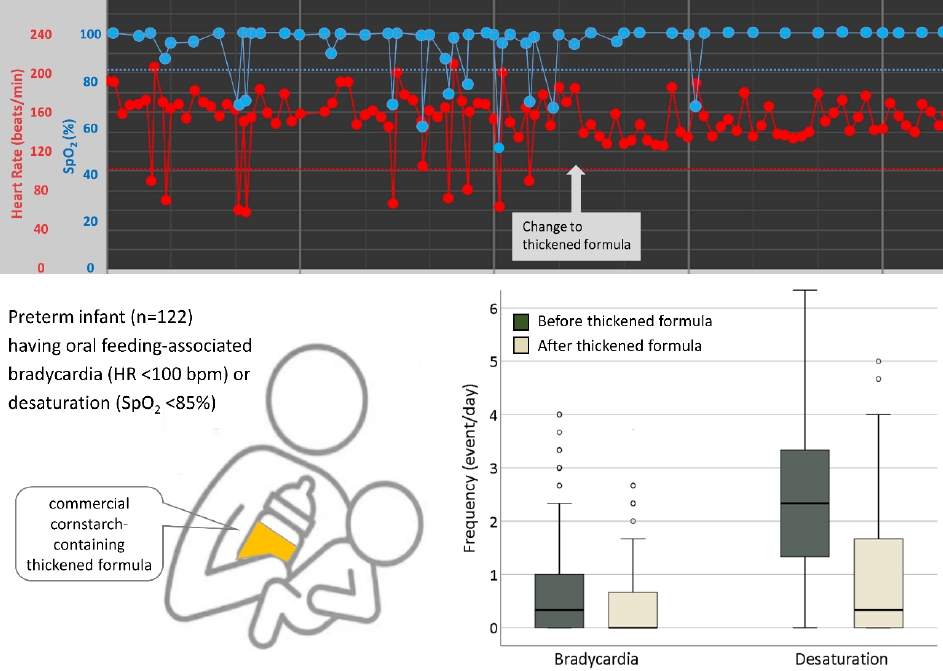
Question: Is a commercial thickened formula able to alleviate oral feeding-associated desaturation and bradycardia in preterm infants?
Finding: Thickened formula feeding significantly reduced oral feeding-associated desaturation and bradycardia in preterm infants.
Meaning: Thickened formula feeding stabilizes oxygen saturation and heart rate during oral feeding among preterm infants with feeding difficulties.
- Editorial
- Endocrinology
- Bisphenol A leaching from polycarbonate baby bottles into baby food causes potential health issues
- Ga Won Jeon
- Clin Exp Pediatr. 2022;65(9):450-452. Published online July 25, 2022
-
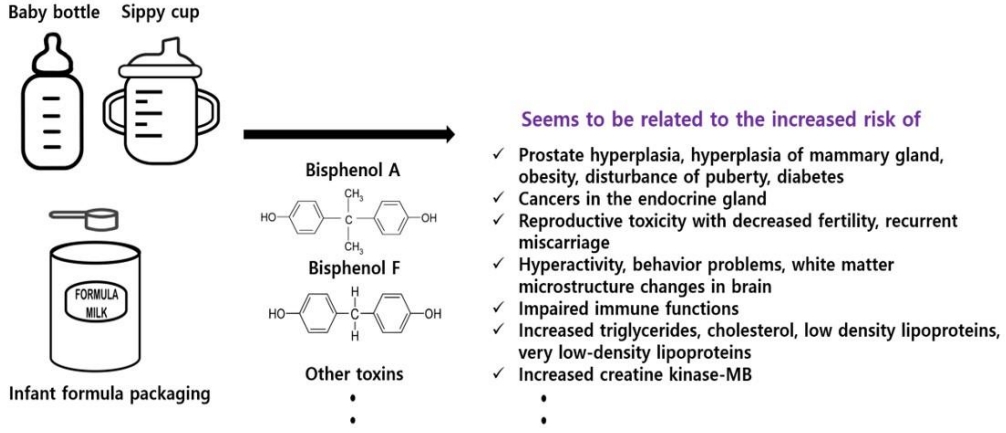
Can bisphenol A (BPA) leach out from polycarbonate baby bottles into baby food? BPA and other toxic materials can leach out from baby bottles and increase the risk of various health problems, including endocrine disturbances. Although the use of BPA in baby bottles has been banned, many developing countries still use it, which can cause health issues. Thus, public awareness of this issue is required.
- Original Article
- Other
- Risk factors and screening timing for developmental dysplasia of the hip in preterm infants
- Ga Won Jeon, Hye Jung Choo, Yong Uk Kwon
- Clin Exp Pediatr. 2022;65(5):262-268. Published online November 5, 2021
-
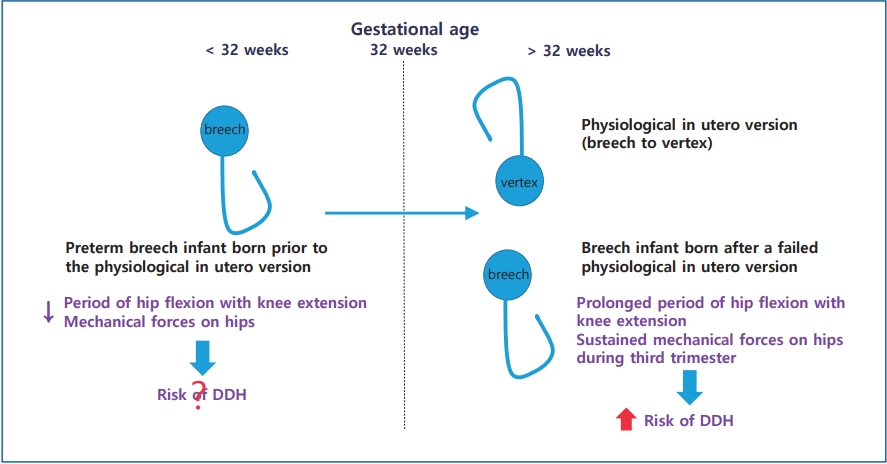
Question: When is the best screening timing and what is the risk factor for developmental dysplasia of the hip (DDH) in preterm infants?
Finding: Ultrasonography performed earlier than 38 weeks of postmenstrual age caused unnecessary subsequent ultrasonography. DDH did not occur predominantly on the left side or in breech infants.
Meaning: The screening timing, etiology, and risk factors for DDH in preterm infants are somewhat different from those in term infants.
- Review Article
- Neonatology (Perinatology)
- Pathophysiology, classification, and complications of common asymptomatic thrombocytosis in newborn infants
- Ga Won Jeon
- Clin Exp Pediatr. 2022;65(4):182-187. Published online October 18, 2021
-
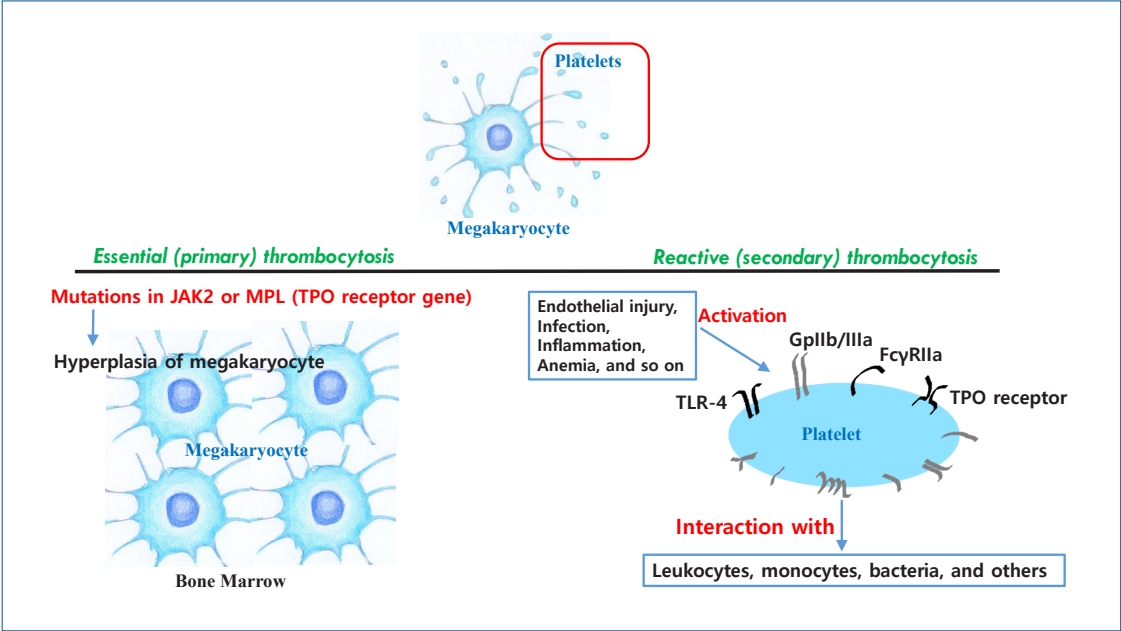
· Thrombocytosis, common in newborns and infants (<2 years) (3%–13%), is caused by elevated thrombopoietin (TPO) concentrations.
· Serum TPO levels are significantly higher immediately to 1 month postnatal and decrease with age.
· Platelet counts are positively correlated with gestational age at birth and postnatal age.
· Thrombocytosis is more common in preterm than in term infants.
· Thrombocytosis in newborns is reactive and resolves spontaneously without complications.
- Other
- Comparison of diagnostic and treatment guidelines for undescended testis
- Jaeho Shin, Ga Won Jeon
- Clin Exp Pediatr. 2020;63(11):415-421. Published online March 23, 2020
-

Primary caregivers should consider surgical specialist referral of patients with undescended testis if no descent occurs by 6 months, undescended testis is newly diagnosed after 6 months of age, or testicular torsion is suspected. Orchiopexy is recommended between 6 and 18 months at the latest. The original location of the testes and the age at orchiopexy are predictive factors for infertility and malignancy later in life.
- Original Article
- Neonatology (Perinatology)
- Hypoxia-inducible factor: role in cell survival in superoxide dismutase overexpressing mice after neonatal hypoxia-ischemia
- Ga Won Jeon, R. Ann Sheldon, Donna M Ferriero
- Clin Exp Pediatr. 2019;62(12):444-449. Published online October 18, 2019
-
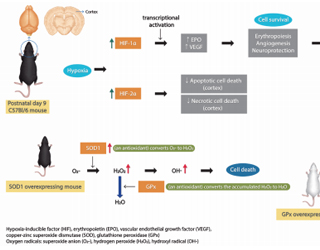
Background: Sixty percent of infants with severe neonatal hypoxic-ischemic encephalopathy die, while most survivors have permanent disabilities. Treatment for neonatal hypoxic-ischemic encephalopathy is limited to therapeutic hypothermia, but it does not offer complete protection. Here, we investigated whether hypoxia-inducible factor (HIF) promotes cell survival and suggested neuroprotective strategies.
Purpose: HIF-1α-deficient mice have increased brain injury after neonatal hypoxia-ischemia (HI), and the...
- Review Article
- Neonatology (Perinatology)
- Surfactant preparations for preterm infants with respiratory distress syndrome: past, present, and future
- Ga Won Jeon
- Clin Exp Pediatr. 2019;62(5):155-161. Published online February 8, 2019
-

Following the first successful trial of surfactant replacement therapy for preterm infants with respiratory distress syndrome (RDS) by Fujiwara in 1980, several animal-derived natural surfactants and synthetic surfactants have been developed. Synthetic surfactants were designed to overcome limitations of natural surfactants such as cost, immune reactions, and infections elicited by animal proteins contained in natural surfactants. However, first-generation synthetic surfactants...
- Respiratory support with heated humidified high flow nasal cannula in preterm infants
- Ga Won Jeon
- Clin Exp Pediatr. 2016;59(10):389-394. Published online October 17, 2016
-
The incidence of bronchopulmonary dysplasia (BPD) has not decreased over the last decade. The most important way to decrease BPD is by weaning the patient from the ventilator as soon as possible in order to reduce ventilator-induced lung injury that underlies BPD, and by using a noninvasive ventilator (NIV). Use of a heated, humidified, high flow nasal cannula (HHHFNC), which...
- Original Article
- Thyroid dysfunction in very low birth weight preterm infants
- Ji Hoon Lee, Sung Woo Kim, Ga Won Jeon, Jong Beom Sin
- Clin Exp Pediatr. 2015;58(6):224-229. Published online June 22, 2015
-
Purpose Thyroid dysfunction is common in preterm infants. Congenital hypothyroidism causes neurodevelopmental impairment, which is preventable if properly treated. This study was conducted to describe the characteristics of thyroid dysfunction in very low birth weight infants (VLBWIs), evaluate risk factors of hypothyroidism, and suggest the reassessment of thyroid function with an initially normal thyroid-stimulating hormone (TSH) as part of a newborn...
- Case Report
- A case of de novo duplication of 15q24-q26.3
- Eun Young Kim, Yu Kyong Kim, Mi Kyoung Kim, Ji Mi Jung, Ga Won Jeon, Hye Ran Kim, Jong Beom Sin
- Clin Exp Pediatr. 2011;54(6):267-271. Published online June 30, 2011
-
Distal duplication, or trisomy 15q, is an extremely rare chromosomal disorder characterized by prenatal and postnatal overgrowth, mental retardation, and craniofacial malformations. Additional abnormalities typically include an unusually short neck, malformations of the fingers and toes, scoliosis and skeletal malformations, genital abnormalities, particularly in affected males, and, in some cases, cardiac defects. The range and severity of symptoms and physical...
- A case of Pfeiffer syndrome with c833_834GC>TG (Cys278Leu) mutation in the
FGFR2 gene - Min Young Lee, Ga Won Jeon, Ji Mi Jung, Jong Beom Sin
- Clin Exp Pediatr. 2010;53(7):774-777. Published online July 31, 2010
-
Pfeiffer syndrome is a rare autosomal dominant disorder characterized by coronal craniosynostosis, brachycephaly, mid-facial hypoplasia, and broad and deviated thumbs and great toes. Pfeiffer syndrome occurs in approximately 1:100,000 live births. Clinical manifestations and molecular genetic testing are important to confirm the diagnosis. Mutations of the fibroblast growth factor receptor 1 (
FGFR1 ) gene orFGFR2 gene can cause Pfeiffer syndrome....
- Original Article
- Effect of SynagisⓇ (palivizumab) prophylaxis on readmission due to respiratory syncytial virus in very low birth weight infants
- Soo Kyoung Park, Yu Jin Jung, Hye Soo Yoo, So Yoon Ahn, Hyun Joo Seo, Seo Heui Choi, Myo Jing Kim, Ga Won Jeon, Soo Hyun Koo, Kyung-Hoon Lee, Yun Sil Chang, Won Soon Park
- Clin Exp Pediatr. 2010;53(3):358-363. Published online March 15, 2010
-
Purpose : The aim of this study was to determine the efficacy of SynagisⓇ (palivizumab) in reducing the respiratory syncytial virus (RSV) readmission rate in very low birth weight infants (VLBWI ) and the subgroup that showed the most effective vaccination. Methods : We enrolled 350 VLBWI who had been discharged alive from the neonatal intensive care unit of Samsung Medical... -
- Analysis of prognostic factors of laparotomy for necrotizing enterocolitis in extremely low birth weight infants
- Jin Kyu Kim, Yi Sun Kim, Hye Soo Yoo, So Yoon Ahn, Hyun ju Seo, Seo Heui Choi, Soo Kyung Park, Yu Jin Jung, Myo Jing Kim, Ga Won Jeon, Soo Hyun Koo, Kyung-Hoon Lee, Yun Sil Chang, Won Soon Park
- Clin Exp Pediatr. 2010;53(2):167-172. Published online February 15, 2010
-
Purpose : With improved survival of extremely low birth weight infants (ELBWI), there is an increase in the incidence of necrotizing enterocolitis (NEC) requiring laparotomy, and the risk of morbidity and mortality in these ELBWI is increased. Thus, we determined the prognostic factors in ELBWI who underwent laparotomy for NEC. Methods : We retrospectively reviewed the medical records of 35 ELBWI... -
- Improved survival rate with decreased neurodevelopmental disability in extreme immaturity
- Ga Won Jeon, Myo Jing Kim, Sung Shin Kim, Jae Won Shim, Yun Sil Chang, Won Soon Park, Mun Hyang Lee
- Clin Exp Pediatr. 2007;50(11):1067-1071. Published online November 15, 2007
-
Purpose : The aim of this study was to determine whether improved survival of extremely low birth weight infants (ELBWI) was associated with decreased neurodevelopmental disability later in life, and also to identify the factors influencing this disability. Methods : ELBWI admitted to the neonatal intensive care unit of Samsung Medical Center, survived, and followed up until the corrected age... -
- Effect of prophylactic indomethacin in extremely low birth weight infants
- Bo Lyun Lee, Su Jin Kim, Soo Hyun Koo, Ga Won Jeon, Yun Sil Chang, Won Soon Park
- Clin Exp Pediatr. 2006;49(9):959-965. Published online September 15, 2006
-
Purpose : The purpose of this study was to investigate the effect of prophylactic indomethacin on reduction of patent ductus arteriosus(PDA) and intraventricular hemorrhage(IVH) in extremely low birth weight infants(ELBWI). Methods : Retrospective review of 84 ELBWI who were admitted to our neonatal intensive care unit from June 2004 to April 2006 was performed. Patients were divided into prophylactic group(n=28) and... -
- Evaluation of Perinatal and Management Factors Associated with Improved Survival in Extremely Low Birth Weight Infants
- Sung Eun Park, Ga Won Jeon, Chang Won Choi, Jong Hee Hwang, Soo Hyun Koo, Yu Jin Kim, Chang Hoon Lee, Yun Sil Chang, Won Soon Park
- Clin Exp Pediatr. 2005;48(12):1324-1329. Published online December 15, 2005
-
Purpose : The aim of this study was to evaluate recent improvements in the survival rate of extremely low birth weight (ELBW) infants and to identify perinatal and management factors that are associated with improved survival. Methods : Two groups of ELBW infants who were admitted to our neonatal intensive care unit (NICU) during two distinct eras : November 1994-December... -
- The Effects of Early Enteral Feeding in Extremely Low Birth-Weight Infants
- Ga Won Jeon, Sung Eun Park, Chang Won Choi, Jong Hee Hwang, Yun Sil Chang, Won Soon Park
- Clin Exp Pediatr. 2005;48(7):711-715. Published online July 15, 2005
-
Purpose : With the recent improved survival of extremely low birth weight infants(ELBWI), enteral feeding has become a major issue. This study investigates the effects of early enteral feeding in ELBWI on their morbidity, duration of hospitalization, and mortality. Methods : ELBWI admitted to the neonatal intensive care unit at Samsung Medical Center from November 1994 to April 2004 who survived... -
- Extubation Time by Birth Weight and the Predictors for Success/Failure at the First Extubation in Extremely Low Birth Weight Infants
- Chang Won Choi, Sung Eun Park, Ga Won Jeon, Eun Jung Yoo, Jong Hee Hwang, Yun Sil Chang, Won Soon Park
- Clin Exp Pediatr. 2005;48(5):488-494. Published online May 15, 2005
-
Purpose : To outline the aspects of extubation by birth weight and find the predictors for success/ failure at the first extubation in extremely low birth weight infants. Methods : One hundred thirteen extremely low birth weight infants(<1,000 g) who were admitted to NICU at Samsung Seoul Hospital between Jan. 2000 and Jun. 2004 were enrolled. Clinical characteristics that are thought... -
-

-
-

-

-
Impact Factor3.2
-
8.02023CiteScore94nd percentilePowered by







